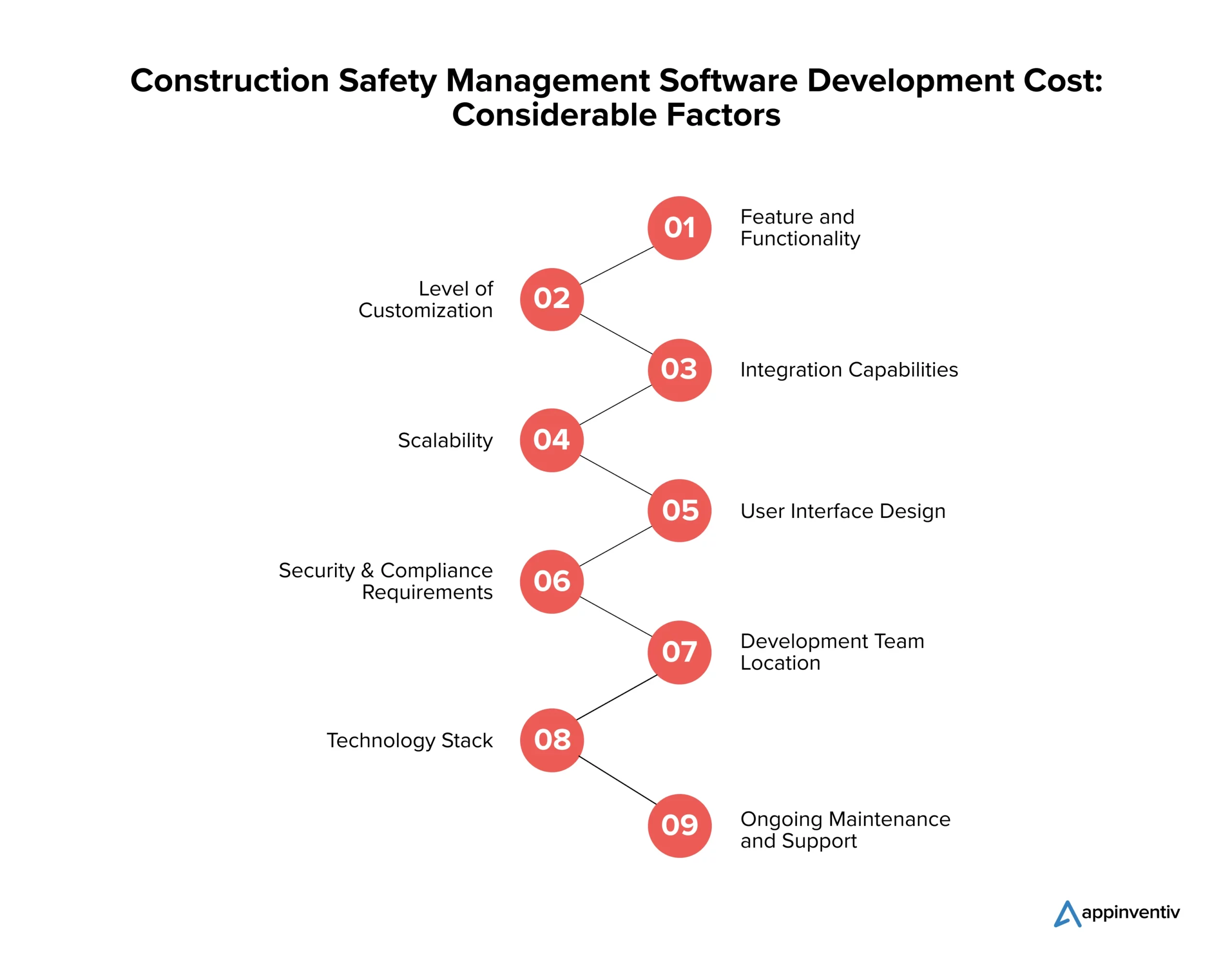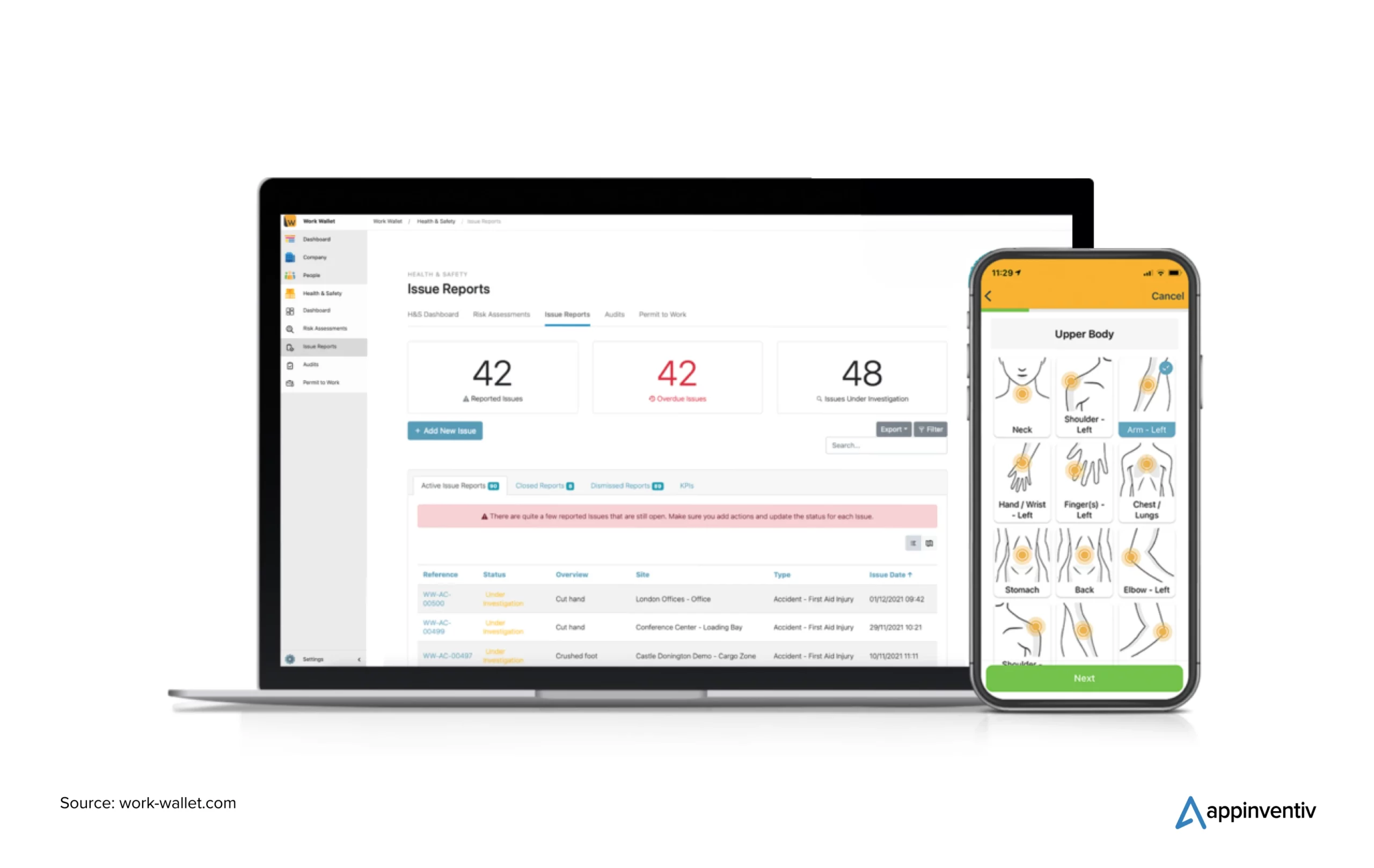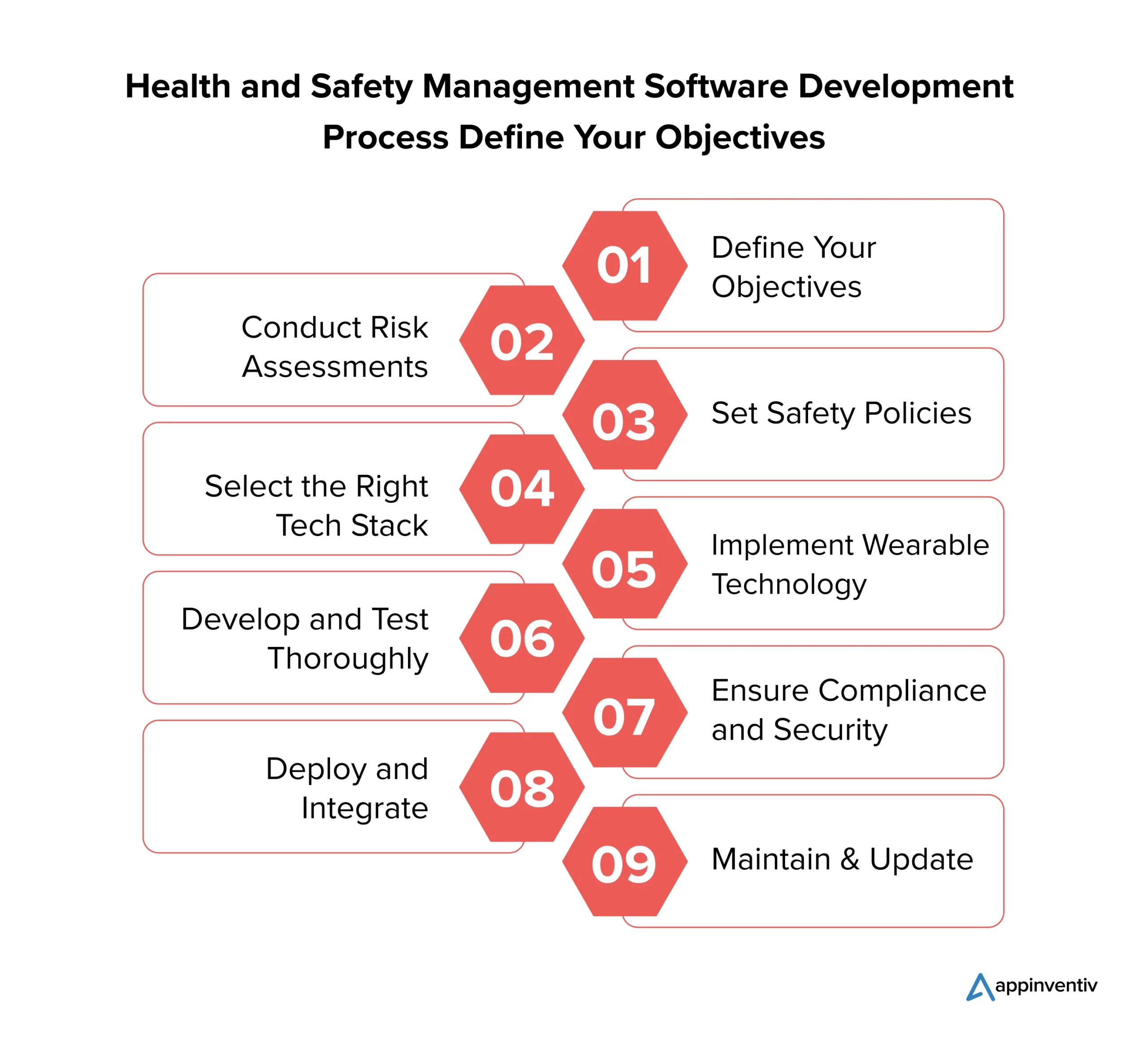- Importance of Construction Health and Safety Management Software
- Factors Affecting White-Label Construction Health and Safety Management Software Development Cost
- Feature and Functionality
- Level of Customization
- Integration Capabilities
- Scalability
- User Interface Design
- Security and Compliance Requirements
- Development Team Location
- Technology Stack
- Ongoing Maintenance and Support
- Key Features to Add During Construction Safety Software Development
- Labor Hours and Scheduling Management
- Comprehensive Project Management
- Photo Documentation with Markups
- Cross-Platform Compatibility
- Injury Tracking and Reporting
- Voice-to-Text Functionality
- Risk Mitigation
- Company Training Modules
- How to Develop a White-Label Construction Health and Safety Management Software?
- Define Your Objectives
- Conduct Risk Assessments
- Set Safety Policies
- Select the Right Tech Stack
- Implement Wearable Technology
- Develop and Test Thoroughly
- Ensure Compliance and Security
- Deploy and Integrate
- Maintain and Update
- Appinventiv’s Expertise in White-Label Construction Safety Software Development
- FAQs
Construction sites are inherently hazardous, where even minor mistakes can result in serious injuries. The constant use of heavy machinery, work at high elevations, exposure to perilous materials, and overreliance on manual labor demand rigorous attention to safety. Without proper attention and safety measures, these risks can lead to severe injuries, project delays, expensive medical bills, and even fatalities. This highlights the pressing need for construction safety software development.
Comprehensive health and safety management software is not just a tool but a dire necessity that helps construction companies protect their workers’ well-being, minimize the likelihood of costly delays, and avoid legal complications from workplace accidents.
While many off-the-shelf health and safety systems are already available in the construction software market, organizations still prefer to develop their own custom software that can better align with their specific business needs. Additionally, many businesses also prefer building a white-label solution that can be customized to meet the unique requirements of a construction firm and maintain a consistent brand identity.
With all these enticing benefits, you might wonder how much construction health and safety management software development costs. While there is no one-size-fits-all formula to answer the question, the costs typically range between $30,000 to $300,000 or more. While it is just a rough estimate; the actual cost can increase or decrease depending on various factors (details later).

Importance of Construction Health and Safety Management Software
Health and safety software for construction is essential for protecting workers and ensuring the smooth progress of projects. It involves a comprehensive system of policies and practices to reduce risks and enhance safety on the job site. This proactive approach not only prevents injuries but also helps keep projects on track, controls costs, and meets regulatory requirements.
A health and safety management system in construction offers a structured way to identify, assess, and manage the risks associated with construction work. By integrating safety protocols, ensuring compliance with laws, and facilitating continuous improvement, such software aims to create a safer work environment and guarantee that every worker goes home safely at the end of each day.
By leveraging such a white-label system, construction companies can enhance their safety practices, reduce risks, and ensure a safer work environment.
Also Read: How Much Does It Cost to Build a White-label Construction Bidding Software?
Factors Affecting White-Label Construction Health and Safety Management Software Development Cost
Several factors can impact the cost to build a white-label construction safety management software. Let’s examine each factor in detail to better understand how it influences construction safety software development expenses.

Feature and Functionality
Your construction health and safety management software development cost will rise as you incorporate advanced and specialized features like real-time hazard alerts, compliance tracking, and integration with wearable safety devices. To secure the future of construction safety software, it is crucial to build it with advanced functionalities and cutting-edge technologies like artificial intelligence (AI), IoT, AR/VR, and Digital Twin.
Here is an overview of white-label construction safety management software development cost and timeline based on its features and complexity level:
| App Complexity | Average Timeline | Average Cost |
|---|---|---|
| Simple Solution with Basic Features | 3-4 months | $30,000-$50,000 |
| Medium Complex Software with Moderate features | 4-9 months | $50,000-$120,000 |
| Highly Complex System with Advanced Features | 9 months to 1 year or more | $120,000-$300,000 or more |
Level of Customization
The custom construction safety management software development cost is also affected by the level of customization it requires. The extent to which the software needs to be tailored for different clients, including branding, specific safety protocols, and unique feature sets, will significantly impact the development cost and associated timeline.
Integration Capabilities
Integrating white-label construction health and safety management software with existing systems like ERP, project management tools, or equipment tracking software increases development complexity and cost. As the number of required interfaces grows, so does the need for advanced technical expertise, which drives up the development cost and timeline.
Scalability
Designing the software to accommodate a growing number of users or additional construction sites requires more development effort. This includes building a flexible architecture that can handle increased data loads and user activity without compromising performance, which can significantly impact the development cost.
User Interface Design
Creating a user-friendly and adaptable UI/UX that can be easily rebranded for different clients and user needs is crucial for ensuring software success. Designing a user-friendly interface requires expertise in graphic design and usability testing, which can increase construction health and safety management software development costs.
Security and Compliance Requirements
Ensuring that your health and safety software for construction complies with various regulatory standards across different regions will further increase the prevailing cost of developing construction software. Additionally, implementing robust security measures for data protection, particularly when multiple clients use the software, is crucial and adds to the development cost.
Also Read: IT Compliance Regulations for Industries in the US
Development Team Location
The geographic location of your development team can also influence the white-label construction safety management software development costs. Hiring skilled developers with construction and safety software expertise often comes with a higher price tag, particularly if they are based in regions like the UK, the US, Australia, or other developed nations. Conversely, developers in regions like India, Asia, or Eastern Europe often charge less.
Here is a table to provide an in-depth understanding of construction health and safety management software development costs based on the locations of your development team:
| Region | Price Range |
|---|---|
| North America | $40–250/hr |
| Australia | $35–150/hr |
| Western Europe | $35–180/hr |
| South America | $25–120/hr |
| Eastern Europe | $25–110/hr |
| India and Asia | $20–80/hr |
Technology Stack
The choice of the technology stack for construction health and safety management software development can significantly impact development costs. Selecting advanced technologies such as machine learning or artificial intelligence may lead to higher initial expenses. However, these transformative technologies can provide a more robust and scalable solution in the long term, offering enhanced capabilities and long-term value.
Ongoing Maintenance and Support
Regular updates, technical support, bug patches, and ongoing maintenance are crucial to ensure that the software performs optimally and remains up-to-date with industry standards and evolving business needs. It can again add to the construction safety management software development costs.
Key Features to Add During Construction Safety Software Development
Construction health and safety management software carries the weight of multiple responsibilities, from tracking teams across job sites to managing risks and handling documentation. To effectively manage these aspects and maximize the impact of construction health and safety management software, it must include essential features that provide a centralized solution for effective project management and enhanced safety outcomes.

Labor Hours and Scheduling Management
Track employee labor hours and manage schedules directly within the software. This feature ensures that all safety protocols are followed during work hours and helps maintain accurate records for payroll and compliance purposes.
For instance, if an employee is injured, the software can determine whether they were clocked in or out at the time of the incident, providing crucial information to help you address the situation more effectively.
Comprehensive Project Management
Your construction safety management software should work as a project management tool, allowing you to oversee every aspect of your construction projects. This feature helps streamline operations, enter data, break down tasks, track labor activities, and monitor safety protocols.

Photo Documentation with Markups
The software should enable users to attach photos with markups directly to reports or safety checklists. This visual documentation helps identify and address safety hazards more effectively, providing clear and actionable insights for your team.
Cross-Platform Compatibility
Ensure that your software is compatible with both desktop and mobile devices. This flexibility allows workers to access and update safety information on the go, promoting real-time communication and quick response to safety issues.
Injury Tracking and Reporting
The software should offer robust injury tracking features in real time, enabling you to log incidents, generate reports, and analyze patterns to prevent future occurrences. If an injury occurs on the job site, real-time notifications can be proven handy to immediately inform a manager.

Voice-to-Text Functionality
Incorporate voice-to-text capabilities to allow workers to document observations, incidents, or safety notes hands-free. This feature enhances usability, especially in fast-paced or hands-on environments where typing may not be feasible.
You may like reading: Cost of developing an AI Voice and TTS app like Speechify
Risk Mitigation
A core feature of health and safety software for construction is its focus on identifying, assessing, and mitigating risks. By standardizing safety processes and thorough documentation, the software helps prevent accidents and creates a safer work environment.
Company Training Modules
Offer built-in training modules to educate employees on safety protocols, industry standards, and best practices. This feature helps maintain compliance and ensures that all workers are well-informed and prepared to use the software.
How to Develop a White-Label Construction Health and Safety Management Software?
Developing white-label health and safety software for construction involves several key steps to ensure it meets evolving business needs while maintaining brand consistency. Here is a step-by-step process of construction health and safety software development:

Define Your Objectives
Start by clearly defining your software’s goals. What specific challenges in construction safety are you aiming to address? Whether it is reducing workplace accidents, improving compliance, or enhancing communication on-site, having clear objectives will guide the entire development process and ensure the software meets the industry’s needs.
Conduct Risk Assessments
Perform detailed risk assessments to address potential hazards and safety concerns that the software needs to address. Understanding the risks associated with different construction activities will help design features that proactively mitigate these dangers, making the work environment safer for all.
Set Safety Policies
Based on the risk assessments, build a set of safety policies and procedures that the software will help enforce. This could include protocols for hazard reporting, emergency response plans, regulatory compliance obligations, and routine safety checks. These policies will form the backbone of the software, guiding its functionality and user interaction.
Select the Right Tech Stack
Choose a tech stack that meets your goals and budget. Consider the programming languages, frameworks, and databases you choose best suited for developing scalable and secure software. If your safety management system for construction requires advanced features like AI-driven safety analysis or real-time alerts, ensure your tech stack supports these capabilities.
Also Read: Use Cases and Benefits of AI Analytics for Businesses
Implement Wearable Technology
Consider incorporating wearable technology into your health and safety software for construction software. IoT-enabled wearables like smart helmets or vests equipped with sensors can monitor workers’ vital signs, track their location, and detect unsafe conditions. Integrating this data into your software provides real-time insights and enhances safety monitoring.
Develop and Test Thoroughly
When developing custom construction safety management software, focus on building a scalable and user-friendly solution. Once developed, conduct extensive testing to ensure all features and industry safety guidelines work efficiently. This includes functional, usability, and security testing to identify and resolve any issues before deployment.
Ensure Compliance and Security
Ensure your construction safety compliance software is designed to meet industry regulations and federal guidelines, such as OSHA (Occupational Safety and Health Administration). Additionally, prioritize data security, especially when handling sensitive information like incident reports or worker health data. Implement robust encryption and access controls to protect this data from unauthorized access.
Also Read: GDPR Software Compliance – A Comprehensive Checklist
Deploy and Integrate
After testing and quality assurance, you can finally deploy the software to your construction sites and ensure it integrates smoothly with existing systems. Right implementation of construction safety software will enhance its utility, making it a valuable part of your construction management toolkit.
Maintain and Update
Although development and deployment are critical milestones, they are not the final steps in the construction health and safety software development process. Ongoing maintenance and updates are essential to ensure the software’s continued performance and effectiveness. This stage involves addressing emerging safety concerns, fixing bugs, incorporating new features to align with changes in industry regulations, and integrating user feedback through regular updates.
Appinventiv’s Expertise in White-Label Construction Safety Software Development
Are you interested in construction safety software development and seeking assistance from a reputed white-label development services provider? Leverage the expertise of Appinventiv’s skilled team of 1,600+ tech specialists who can turn your vision into a seamless reality.
With a proven track record of delivering 3,000+ successful projects, we consistently help our clients seize market opportunities and achieve business goals. With a deep understanding of the unique challenges and requirements of the construction industry, we deliver custom construction software development services that enhance safety, streamline operations, and ensure compliance.
Our experience in delivering white-label development services ensures that clients not only meet their safety objectives but also gain a competitive edge through innovative, high-quality software. Our commitment to exceptional software development—marked by quality, reliability, and client satisfaction—ensures that your project will not only meet but exceed your expectations.
Discuss your project idea with our tech experts now and get a tailored quotation for construction safety management software development costs and timelines.
FAQs
Q. How much does it cost to build a white-label construction health and safety management software?
A. The cost to build a white-label construction health and safety management software typically ranges from $30,000 to $300,000 or more.
However, it is only a rough estimate; the actual cost for construction safety management software can increase or decrease depending on various factors (refer to the blog for details)
To get a more accurate estimate for construction health and safety management software development cost, contact our software developers now.
Q. What is the timeline to build construction safety management software?
A. The timeline for construction safety software development usually spans from 4 months to a year or more, depending on various factors, including the project’s complexity, features, and customization requirements.
To get a more accurate estimate for your project timeline, discuss your project idea with our efficient software developers.
Q. What are the benefits of construction safety software development?
A. Here are some of the most remarkable benefits of construction safety software development:
Minimizes Workplace Injuries: A safety management system for construction effectively reduces the number and severity of accidents on construction sites.
Streamlines Workflows: It simplifies and automates safety processes, making it easier to manage compliance and mitigate legal risks.
Reduces Risk: The software helps identify potential hazards and manage risks proactively, minimizing the risk of incidents and enhancing workplace safety.
Boosts Productivity: A safer work environment leads to fewer interruptions and errors, helping you deliver projects on time and within budget.
Offers Long-Term Cost Savings: While there is an initial investment in construction safety software development, the software can significantly save money by lowering accident rates and insurance costs.



Construction CRM Integration and Implementation – Benefits, Process, Costs
Efficiency is everything when it comes to the construction sector. Factors like project cost overruns, late delivery, mismanagement of resources, or poor and confusing communication from clients may lead to derailment of the projects at a significant loss. Traditional methods have failed to meet the challenges of tighter timelines and greater complexity that modern construction…

How Much Does it Cost to Build a White Label Construction Accounting Software?
By 2050, Autodesk predicts cranking out around 13,000 new buildings every single day to keep up with a massive urban population of 10 billion people. The need for new housing, schools, and hospitals is a big part of the puzzle—but it’s just the tip of the iceberg. The real hustle? Managing finances. Tracking expenses, processing…

10 Smart Building Technologies Revolutionizing Facility Management
Managing buildings has come a long way from simply ensuring the lights work and the heating is on. Today, technology is changing how facilities are run, making operations smoother, more energy-efficient, and responsive to the needs of occupants. From systems that automatically adjust lighting and temperature to maintenance that can be predicted before issues arise,…
















